Published Jan 4, 2021
One of the worst feelings in the world is receiving written notice that your home, whatever and wherever it may be, is intended to be condemned by the local government. The moment you read that notice, a wave of emotions – fear, anxiety, bitterness, comes over you, and it’s just terrible. It feels a lot like a rug’s been pulled out from under you, and you don’t really know what to do. But all hope is not lost. This article will tackle what leads to a building’s condemnation, what follows, and how you should handle that as a tenant or property owner.

Why are buildings condemned?
Condemnation usually refers to two situations. The first is when it is used similarly as “eminent domain,” which is the government’s right to take private property to convert it for public use. They may exercise this right if they plan to turn a property into a public project, such as a road, highway, or other necessary infrastructure. Of course, in accordance with the Fifth Amendment, the government must provide tenants and property owners with just compensation when using eminent domain.
The second and more troublesome situation is when the government seizes properties that have been deemed unfit by some measure. This likely means that the building did not comply with government codes and standards, or it’s been determined to be unsafe or uninhabitable.
The latter is far more common, and it is in everyone’s best interest that all buildings follow the government’s provisions. Most cities, towns, and counties in the United States adhere to specific building codes designed to ensure the health, safety, and well-being of all its occupants. These provisions specify different requirements, from the structural integrity of a building to its HVAC and utility systems. A jurisdiction’s building code provisions are typically available for the public to read and review.
What are the common causes of building condemnation?
The following are the most common causes of building condemnation:
- natural disasters (e.g., floods, fires, earthquakes)
- unsafe building materials (e.g., asbestos)
- termite infestation
- black mold
- unsafe construction
- unsanitary living conditions
What happens when a building’s been condemned?
For both situations mentioned above, the government unit must deliver written notices to the property owner and/or tenants that live in the building. These notices must contain a copy of the inspector’s report and explain why the building is being condemned. It’s often the case that the government will hold a public hearing to discuss whether a building or its portion should be condemned and why. In the notice, the schedule for this hearing should also be disclosed.
At the hearing, the landlord, occupant, or another party with a direct interest in the matter may challenge the condemnation. The best defense against the condemnation would be to present witnesses and pertinent documents proving otherwise. It would be best to consult a trained inspector to do a thorough assessment of the building and show that it may still be safe and inhabitable after certain repairs are made.
However, in other cases, the authorities may judge the conditions to be too unsafe, which poses an immediate risk to human life. A hearing may be foregone entirely in times like those, and residents will be instructed to evacuate the building immediately.
How to challenge an order to condemn
Once the proper authorities determine a building does not comply with codes and provisions, they may also issue an order to condemn. This order essentially advises residents to vacate the building and the landlord to close it up.
If you’re a resident or tenant, you may contest this order in the following ways:
- Suppose the conditions are relatively manageable, and the landlord can afford the repairs. In that case, you can ask the judge to order the landlord to act on the necessary repairs to avoid condemnation.
- Suppose the conditions are still relatively manageable, but the landlord cannot afford repairs. In that case, you may ask the judge to designate a receiver to manage the property and make the repairs.
If the conditions are too severe to be salvaged, you may have no other choice but to relocate.
Can you get financial assistance from the government?
If a tenant was forced to vacate because of the building’s noncompliance with the Sanitary Code, the local government in which the building is located must provide relocation assistance and payment to them for their moving expenses.
In cases where the landlord was issued a notice to vacate and was in a position where he should have known about the conditions, the tenants’ landlord might be obligated to pay them.
Interested In Cutting Technologies?
For nearly 40 years Cutting Technologies (CTI) has been the go-to demolition contractor for technically demanding, one-off jobs. Our wealth of experience enables CTI to bring “outside-of-the-block” approaches to achieve the impossible. Contractors trust CTI to get the job done right. Take a look at our demolition services on our website.

About The Author
Terrence Tan Ting is an industrial engineer by profession but a full time writer by passion. He loves to write about a wide range of topics from many different industries thanks to his undying curiosity.

